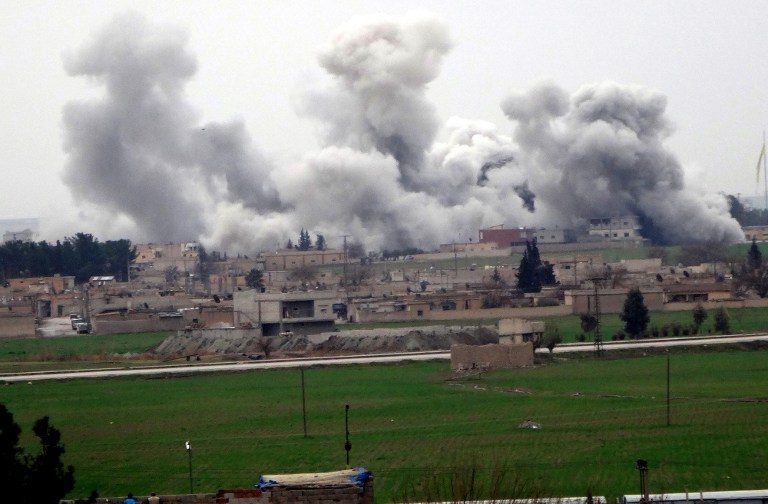SUMMARY
This is AI generated summarization, which may have errors. For context, always refer to the full article.

DAMASCUS, Syria (3rd UPDATE) – Key players in Syria’s war traded accusations Sunday, February 28, over violations of the first major ceasefire in the 5-year conflict, but the truce remained largely intact on its second day.
Aid groups hope to use the lull in fighting that has claimed 270,000 lives and displaced more than half the population to deliver desperately-needed supplies.
A successful truce would also create a more favourable backdrop for peace talks that collapsed in acrimony in early February as a Russia-backed regime offensive in northern Syria caused tens of thousands to flee.
The main opposition group Sunday described the ceasefire as “positive” but lodged a formal complaint with the United Nations and foreign governments about first day breaches.
“We have violations here and there, but in general it is a lot better than before and people are comfortable,” said Salem al-Meslet, spokesman for the Saudi-backed High Negotiations Committee.
Meslet said the opposition would like to see the truce “last forever” and that it was the “responsibility of the United States to stop any violations.”
An HNC letter to UN Secretary General Ban Ki-moon accused Syria’s regime and its allies of committing “24 violations with artillery shelling and five ground operations… in 26 areas held by the moderate opposition.”
The letter, signed by HNC head Riad Hijab, also attacked Russia for conducting “26 air strikes on areas falling within the ceasefire.”
Hijab said the breaches had killed 29 people and wounded dozens.
He also warned it would be “impossible to restart the negotiations process in such coercive conditions.”
The HNC has said it did not receive any maps of areas included in the ceasefire or documents explaining the monitoring mechanism.
Syria’s Al-Watan newspaper, which is close to the government, said Sunday that those maps were still being “kept secret.”
The ceasefire does not apply to territory held by the Islamic State group and Al-Qaeda affiliate Al-Nusra Front.
The Syrian Observatory for Human Rights, a Britain-based monitor, said regime forces and the Islamic State (ISIS) group were locked in clashes around the town of Khanasser in Aleppo province on Sunday.
The fighting left at least 26 pro-government fighters and 14 ISIS jihadists dead, the monitor said.
‘Strange silence’
Saudi Arabia, a staunch opponent of Syrian President Bashar al-Assad, also accused Russia of flouting the ceasefire and targeting “moderate opposition” groups.
“Things will become clearer in the coming days on whether the regime and Russia are serious or not about the ceasefire,” Saudi Foreign Minister Adel al-Jubeir said.
Russia, which has waged a 5-month bombing campaign to support Assad, blamed “moderate” rebels and jihadists for 9 ceasefire violations, including from Turkish territory.
But “on the whole, the ceasefire regime in Syria is being implemented,” Lieutenant General Sergei Kuralenko, head of Moscow’s coordination center in Syria, was quoted as saying by Russian news agencies.
In Damascus, student Mehdi al-Ani spent Sunday at his university’s cafe with friends.
“Yesterday, we only heard two or three shells – but I pretended like I didn’t hear anything. The ceasefire will continue, God willing,” he said.
In Syria’s second city Aleppo, children strolled to school without hugging walls for fear of rocket attacks, an AFP correspondent said.
“There’s something strange in this silence. We used to go to sleep and wake up with the sound of raids and artillery,” said Abu Omar, 45, who runs a bakery in rebel-held east Aleppo.
Yacoub El Hillo, the UN’s humanitarian coordinator for Syria, said the ceasefire would allow aid to be delivered to an extra 154,000 people living in besieged areas over the next 5 days.
“It is the best opportunity that the Syrian people have had over the last five years for lasting peace and stability,” he added.
‘Inevitable setbacks’
The Syrian Observatory for Human Rights reported air strikes – believed to be either Syrian or Russian – on 7 villages in Hama and Aleppo provinces.
It was unclear if the raids hit areas covered by the ceasefire. Observatory head Rami Abdel Rahman said only one of the villages, Kafr Hamra in Aleppo, is controlled by Al-Nusra and the others are held by non-jihadist rebels.
As recriminations flew, Washington urged patience.
“Setbacks are inevitable,” a senior US administration official said.
“Even under the best of circumstances, we don’t expect the violence to end immediately. In fact, we are certain that there will continue to be fighting, in part because of organizations like ISIL (Islamic State) and Al-Nusra.”
UN envoy Staffan de Mistura aims to relaunch peace talks on March 7 if the ceasefire lasts and more aid is delivered.
Israel welcomed the ceasefire but warned it would not accept Iranian “aggression” or the supply of advanced weapons to Hezbollah, the pro-regime Lebanese Shiite militia.
“It’s important it remains clear any agreement in Syria must include an end to Iranian aggression aimed at Israel from Syria’s territory,” Prime Minister Benjamin Netanyahu said. – Maher al-Mounes with Karam al-Masri in Aleppo, AFP / Rappler.com
Add a comment
How does this make you feel?
There are no comments yet. Add your comment to start the conversation.